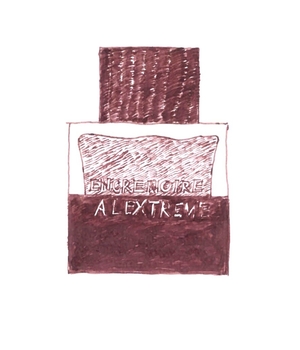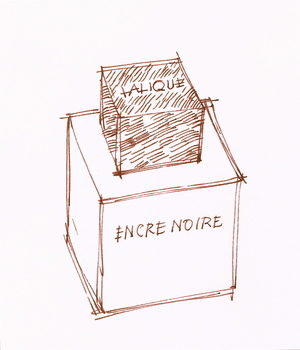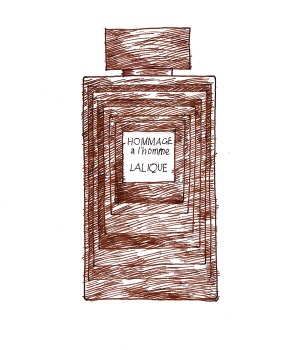Tagged With ‘Lalique’
Lalique
Encre Noire à l’Extrême
18 November, 2016
 Lalique has been associated with perfume since 1907, when its founder, René Lalique, began to produce alluring glass bottles for the prodigiously entrepreneurial French perfumer François Coty. But it wasn’t until 1992 that the company launched a perfume of its own with Lalique de Lalique.
Lalique has been associated with perfume since 1907, when its founder, René Lalique, began to produce alluring glass bottles for the prodigiously entrepreneurial French perfumer François Coty. But it wasn’t until 1992 that the company launched a perfume of its own with Lalique de Lalique.
Encre Noire – literally ‘black ink’ – was released in 2006, and was quickly hailed as one of the best vetiver scents around. Created by the talented perfumer Nathalie Lorson from the Swiss fragrance-and-flavour firm Firmenich, it blends good-quality vetiver (whose earthy, slightly bitter smell comes from the roots of a tropical grass) with the woody notes of cypress and a long-lasting synthetic called Cashmeran, whose effect is as plush as its name.
Though Encre Noire is still available, and presumably a steady seller, Lalique has celebrated its 10th anniversary by launching a slightly more powerful, punchy version called Encre Noire à l’Extrême. Created again by Nathalie Lorson, the new perfume blends two different vetivers, one from Haiti and the from Java, and adds touches of iris, incense, sandalwood and patchouli.
If rather stronger and heavier than the earlier Encre Noire, it’s still a very attractive fragrance, and while Lalique claims that Encre Nore à l’Extrême ‘redefines masculinity’, we feel that it would smell equally appealing on a man or a woman. Think ink.
Lalique
Encre Noire
15 April, 2015
 Calling a perfume ‘black ink’ has intriguing connotations. ‘Black’ or ‘Noir(e)’ has been the perfume industry’s shorthand for ‘edgy’ ever since the 1998 launch of the striking but hard-to-wear Bulgari Black. Among the many followers in its wake we’ve had Ambre Noir, 1881 Black, Armani Privé Cuir Noir, Bois Noir, Coco Noir, Cologne Noir, Dahlia Noir, Datura Noir, Eau Noir, Fourreau Noir, even (I kid you not) Hello Kitty Noir.
Calling a perfume ‘black ink’ has intriguing connotations. ‘Black’ or ‘Noir(e)’ has been the perfume industry’s shorthand for ‘edgy’ ever since the 1998 launch of the striking but hard-to-wear Bulgari Black. Among the many followers in its wake we’ve had Ambre Noir, 1881 Black, Armani Privé Cuir Noir, Bois Noir, Coco Noir, Cologne Noir, Dahlia Noir, Datura Noir, Eau Noir, Fourreau Noir, even (I kid you not) Hello Kitty Noir.
So Encre Noire (which was launched in 2006) follows a bit of a bandwagon, though at least its name is better than most. It’s a nostalgic name, since hardly anyone uses ink (black or otherwise) these days, yet it’s evocative too – I can kind of imagine the smell of black ink, even though I must have been a teenager the last time I opened an actual bottle of the stuff.
Whatever you think about the name, Encre Noire is a fine addition to the many men’s perfumes to be based on the smell of vetiver, the vigorous tropical grass whose roots have a wonderful dry, earthy, slightly musky scent. My all-time favourite is Guerlain’s simply-named Vétiver, which starts with a burst of lemony freshness, but Encre Noire foresakes such tricks and sticks resolutely with vetiver all the way through.
I say ‘all the way through’, but of course it’s actually a bit more complicated than that, thanks to Nathalie Lorson, senior perfumer at the giant Swiss fragrance company Firmenich. When she created Encre Noire she cleverly smoothed off some of vetiver’s rough edges, adding tiny amounts of cypress extract (which has a dry, woody, slightly resinous smell), as well as synthetic musk and so-called ‘cashmere wood’. This is actually 2,3,5,6,7-hexahydro-1,2,3,3-pentamethyl-4h-inden-4-one, a chemical sold under the brand name of Cashmeran, which is widely used in perfumery (and household products) and has a soft, gently woody smell.
The final result an appealing and long-lasting perfume, though some people are always going to find vetiver too dry and bitter-smelling for their taste. As for the bottle, a black glass cube with a square wood-effect cap, I like its inkwell look, but its glossy surfaces all too quickly get smeared with fingerprints, and the lettering is so spare – just a bare ENCRE NOIRE in thin white sans-serif capitals – that (to me at least) it ends up looking a bit cheap and half-considered, though I’m sure it was anything but.
Minor gripes aside, this is a fine perfume, and even if, in the end, I think it’s unlikely to supplant Guerlain’s Vétiver in my affections, I think its popularity is well deserved.
Lalique
Hommage à l’homme
29 April, 2014
 Now here’s a tough one. Hommage à l’homme was the first perfume I reviewed whose London launch I attended and whose creator I met, but it’s also the first perfume I reviewed that I didn’t actually enjoy.
Now here’s a tough one. Hommage à l’homme was the first perfume I reviewed whose London launch I attended and whose creator I met, but it’s also the first perfume I reviewed that I didn’t actually enjoy.
On the whole I dislike knocking things, and generally I’d rather not mention fragrances that do nothing for me, but given the number of new launches each year there are bound to be some duds, so if I’m going to recommend scents that appeal to me it seems only honest to come clean about the ones that don’t.
Lalique has a long association with perfume, going back to 1908, when the ground-breaking French perfumer François Coty commissioned René Lalique to design perfume labels for him. Soon Lalique was designing perfume bottles too, and over the decades the company became known for its innovative techniques and the superb quality of its workmanship.
It wasn’t until 1992, though, that Lalique launched a perfume of its own, the imaginatively named Lalique de Lalique. There are now 19 Lalique perfumes to choose from, and Hommage de l’homme is the fourth to be marketed for men.
Hommage de l’homme marks two decades of perfume production, so you’d hope it’d be something special. My problem is that – to me at least – it smells totally generic, and not in a good way. Yes, I can vaguely smell the violets and saffron that we’re told it contains, but they’re completely overpowered by the same toxic chemical smell that spoils so many otherwise promising men’s fragrances.
Ever since I first recoiled from my first sniff of Dior’s Higher in 2001, every other mainstream men’s fragrance seems to have been stuffed full of the same noxious ingredient, which gets right up my nose. It has a harsh, acrid odour, like you get when your computer blows up – a burnt-plastic smell that I wouldn’t want in a toilet cleaner, never mind a perfume I might spray on my skin.
I’ve been puzzling what this secret component could be, if only so I could avoid it – could it be some kind of natural or synthetic extract of black pepper? Would someone like to tell me? Whatever it is, for me it’s a trend that, like Ugg boots, has long outlasted its welcome. Please, perfumers, move on.
PS: Finally someone has identified it: the much-appreciated Grooming Guru, Lee Kynaston – now we know!